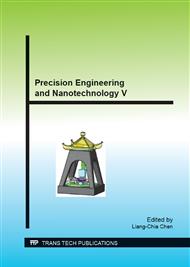p.430
p.437
p.446
p.453
p.458
p.463
p.469
p.475
p.483
Investigation of Removal Mechanism of Sapphire in Plasma Assisted Polishing
Abstract:
Single crystal sapphire is widely used as the material for precision equipments, due to its high hardness, chemical inertness and light transmission. However, it is difficult to obtain a scratch-free and damage-free sapphire surface with high-efficiency through traditional mechanical polishing or etching. We developed plasma assisted polishing (PAP) for the finishing of difficult-to-machine materials, such as silicon carbide, diamond, and sapphire. In this article, preliminary research results are showed about PAP applied to polishing of single crystal c-plane sapphire substrates. Combination of helium based atmospheric pressure water vapor plasma irradiation and silica abrasive polishing drastically increased removal rate of the sapphire c-plane. XPS measurements of the surfaces with and without irradiation of water vapor plasma revealed that alumina hydrate was formed by plasma irradiation at low temperature of less than 40°C. It is assumed that formation of alumina hydrate promoted the removal rate of sapphire.
Info:
Periodical:
Pages:
458-462
Citation:
Online since:
August 2014
Authors:
Keywords:
Price:
Сopyright:
© 2015 Trans Tech Publications Ltd. All Rights Reserved
Share:
Citation:


